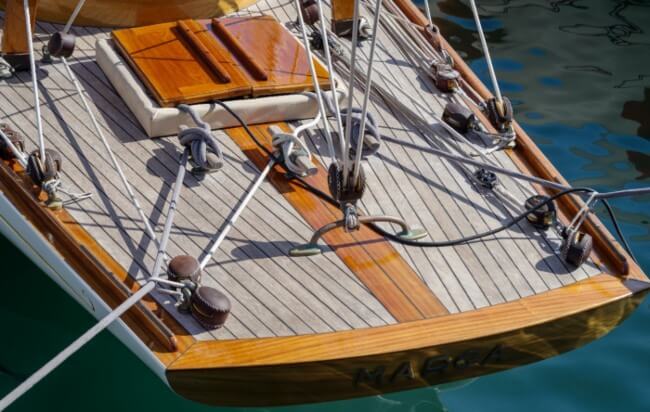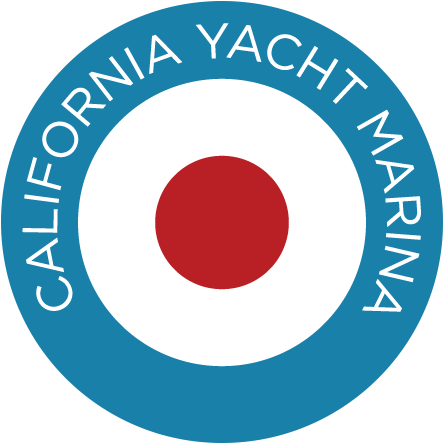California Yacht Marina
A Guide to the Different Parts of a Sailboat

Sailing is a favorite pastime for millions of Americans. There’s nothing quite like navigating the vast, open sea, guided by the wind and steered by skillful hands. Modern sailboats are a marvel of engineering and design, with intricate parts working together to catch the wind and steer the vessel. If you want a better appreciation for your sailboat, it’s helpful to learn the names and functions of its various components. Here’s a deep dive into 16 different parts of a sailboat.
1. Hull
The hull is the part that floats on the water, making it the foundation of any sailboat. Hulls come in many shapes and designs that affect how they interact with the water. For instance:
- Displacement hulls move aside a volume of water equal to their own weight. They cut through the water rather than riding on top of it, making them ideal for cruising at moderate speeds.
- Planing hulls rise up and glide across the water’s surface. They’re lighter and flatter, capable of faster speeds because they reduce drag.
In Southern California, particularly around the South Bay, the calm and predictable waters make it an ideal location for both monohulls and catamarans.
Sailboats can have one or more hulls, with each design offering a different sailing experience:
- Monohulls have a classic single-hull design well-suited for general sailing conditions. They’re known for their balanced speed, agility, and simplicity.
- Catamarans feature two parallel hulls for greater stability and deck space. They’re less likely to capsize and offer a smoother ride, making them ideal for leisure and long-distance cruising.
- Trimarans consist of a central hull flanked by two smaller ones, offering an excellent mix of stability, space, and speed. They’re agile and fast, perfect for racing and adventurous sailing.
2. Keel
The keel is a flat blade-like structure sticking down into the water from the bottom of the hull. It counterbalances the force of the wind to keep the boat stable and upright, preventing it from capsizing. Keels come in several forms:
- Full keels run along most of the hull’s length, providing ample stability and protection for the rudder. They’re great for long-distance cruising thanks to their ability to maintain a straight course.
- Fin keels are shorter and deeper than full keels for a good balance between speed and stability. They make sailboats more maneuverable, especially in races or other conditions requiring quick turns.
- Winged keels feature “wings” or extensions at the bottom to reduce drag and improve performance in shallow water. They also enhance stability by lowering the center of gravity.
- Canting keels are an advanced type of keel that can pivot or swing from side to side, allowing sailors to actively adjust the boat’s balance. This functionality is especially useful for optimizing performance in windy conditions and during races.
The waters around Cabrillo Marina in San Pedro are perfect for testing the maneuverability of fin keels, while the deeper waters near CYM-Wilmington Marina are ideal for full keels.
3. Rudder
The rudder is the sailboat’s steering device, a flat piece of material positioned vertically beneath the boat. It directs the boat’s path by altering the flow of water passing by. The rudder works through a simple yet effective mechanism: when a sailor turns the helm (tiller or steering wheel), the rudder pivots to one side, creating a force that turns the boat. Small boats often use a tiller, or a stick attached to the top of the rudder, for steering. Larger boats generally use a wheel for greater leverage.
Navigating the busy waters of Marina del Rey Marinas and King Harbor Marinas in Redondo Beach requires precise control, making a well-functioning rudder essential.
4. Bilge
The bilge is the lowest compartment inside the hull of a sailboat, where water tends to collect from leaks, condensation, or waves splashing aboard. Manual or electric bilge pumps remove this accumulated water to keep the vessel afloat.
Regular maintenance of the bilge is crucial, especially when docking at marinas in Southern California, where the saltwater environment can accelerate wear and tear.
5. Bow
The bow is the forward part of a sailboat, designed to cut through the water as the vessel moves. Its shape and design are carefully considered to minimize resistance and ensure smooth sailing. The bow may feature a bow sprit, which extends forward to support additional sails and enhance the boat’s performance in various wind conditions.
The bow’s design is particularly important when navigating the choppy waters near Catalina Island and Marinas in Southern California.
6. Stern
The stern is the rear part of a sailboat, with designs varying widely. This component affects the vessel’s hydrodynamics and stability. The stern often houses the cockpit, navigation and sailing instruments, and seating for passengers and crew members.
A well-designed stern is essential for comfort and functionality, especially when mooring at Port Royal Marina in King Harbor, where social gatherings on the deck are common.
7. Navigational Equipment
Modern sailboats feature advanced navigational equipment to ensure safe passage. This includes compasses for directional orientation, GPS for precise positioning, and maps or nautical charts with crucial maritime information.
Having reliable navigational equipment is crucial when sailing in and out of the busy Long Beach and Los Angeles Harbor near Cabrillo Marina and CYM-Wilmington.
8. Mast
The mast is a tall, vertical pole that supports the boat’s sails. There are different types of masts, each serving unique sailing needs:
- The foremast is near the front of the boat, making it the first mast on multi-mast vessels.
- The mainmast is the tallest and primary mast on a sailboat, situated in the center or just aft of center.
- The mizzenmast is found on sailboats with three masts, located behind the mainmast and typically shorter than the other two.
The masts at California Yacht Marina locations are often seen towering over the docks, a testament to the vibrant sailing community.
9. Main Sail
As the most prominent sail, the main sail captures the wind to propel the boat forward. It attaches to the mast and boom, working in harmony with these components to manage the wind’s power. The main sail comprises several parts:
- The luff is the forward edge of the sail, leading into the wind.
- The leech is the back edge of the sail, where the wind exits.
- The foot is the bottom edge of the sail, horizontal to the deck.
- The head is the top corner of the sail, opposite the foot.
- Battens are rigid inserts that help maintain the sail’s shape.
- Telltales are small strips or yarns that indicate wind direction and sail alignment.
- The clew is the lower aft corner of the sail, where tension is applied to shape the sail.
Sailing enthusiasts at all California Yacht Marinas often adjust their main sails to catch the perfect breeze coming off the Pacific Ocean.
10. Boom
The boom is a horizontal pole extending from the mast, to which the bottom of the sail is attached. It moves side to side and tilts up and down, allowing sailors to adjust the sail’s angle and tension, affecting how the boat harnesses the wind.
Proper handling of the boom is essential for safe and efficient sailing, especially in the variable winds near Redondo Beach and the Port of Los Angeles Marinas.
11. Kicking Strap (Boom Vang)
The kicking strap, or boom vang, is a rigging component that controls the boom’s height and the angle of the sail. It prevents the boom from lifting and maintains optimal sail shape, especially when sailing downwind. Adjusting tension on the vang allows sailors to fine-tune the sail’s efficiency and stability.
Experienced sailors at Port Royal Marina often tweak their boom vangs to optimize performance during races.
12. Topping Lift
The topping lift is a line or wire running from the top of the mast to the end of the boom. It supports the boom when the sail is not raised, preventing it from dropping to the deck. Adjusting the topping lift’s tension keeps the boom at the correct height for better sail shape and performance.
Maintaining thetopping lift is crucial for safety and convenience, especially when docking at Cabrillo Marina and the Cabrillo Beach Yacht Club (CBYC).
13. Jib and Genoa
The jib is a triangular sail set between the mast and the forestay. It directs airflow around the main sail, which improves steering and adds speed, especially when sailing upwind. A genoa is a type of jib that is larger than the main sail, extending back beyond the mast to overlap the main sail.
The use of jibs and genoas is common among sailors at the San Pedro Yacht Club (SPYC) and CYM-Wilmington Marina, who often navigate the challenging winds of the South Bay.
14. Forestay
The forestay is a rigging line running from the mast to the bow. It supports the front of the mast and is the attachment point for the jib or genoa. The tension on the forestay affects the sail’s shape and performance.
Proper tensioning of the forestay is essential for optimal sail performance, especially in the variable wind conditions in Santa Monica Bay near Port Royal Marina and King Harbor Yacht Club.
15. Spinnaker
The spinnaker is a large, balloon-shaped sail designed for sailing downwind. It catches a large amount of wind, propelling the boat with significant force. This sail is known for its dramatic appearance and the skill required to handle it.
Spinnakers are a common sight during regattas at Cabrillo Marina, and the Los Angeles Yacht Club (LAYC) adding a splash of color to the competitive sailing scene.
16. Backstay
The backstay is a cable running from the top of the mast down to the stern of the boat. It supports the mast, keeping it upright and properly tensioned. Backstays fall into one of two categories:
- Permanent backstays are fixed lines that provide constant support for the mast.
- Running backstays can be tightened or loosened, offering flexibility in sail shape and mast bend for different sailing conditions.
Adjusting the backstay is crucial for maintaining mast stability, especially when sailing in the open waters near San Pedro Bay and Los Angeles Harbor Wilmington Marinas.
Set Sail with Confidence
If you’re eager to join a community where sailing enthusiasts thrive, check out everything California Yacht Marina has to offer. We operate three marinas in the Los Angeles area—Cabrillo and Wilmington off LA Harbor and Port Royal off Santa Monica Bay—each with flexible docking options, five-star amenities, and convenient access to nearby beaches and attractions. Our reciprocal berthing program allows you to explore different CYM locations without additional fees. Whether you’re staying for a month or just one night, we would be glad to serve you! For more information about applying for a slip at one of our Los Angeles-area marinas, please call us at (310) 732-2252.
